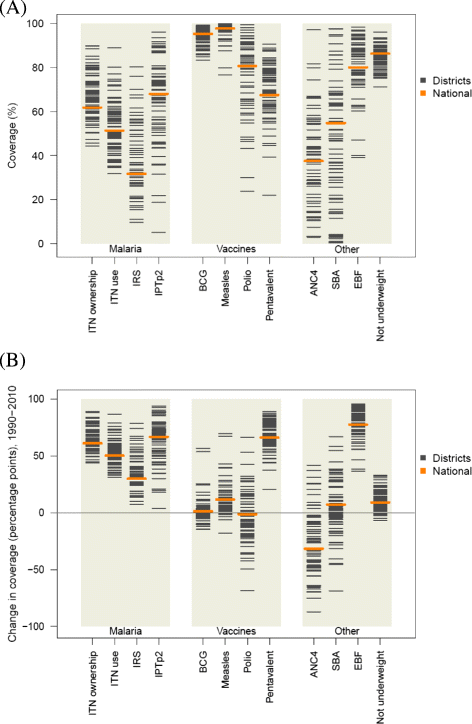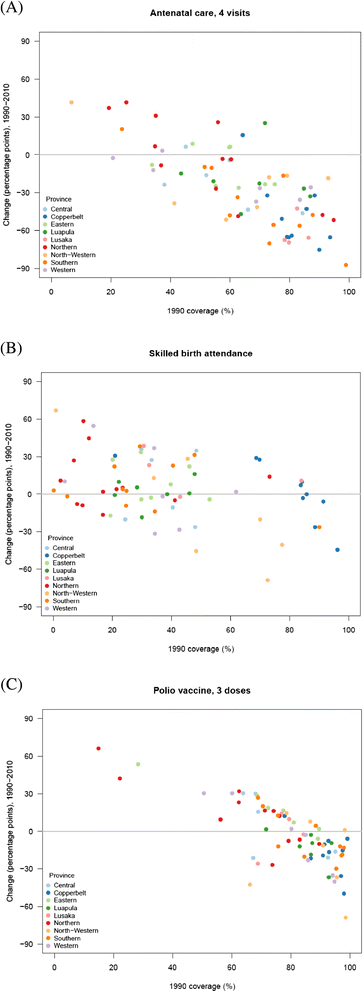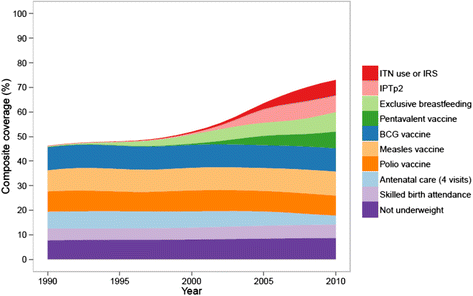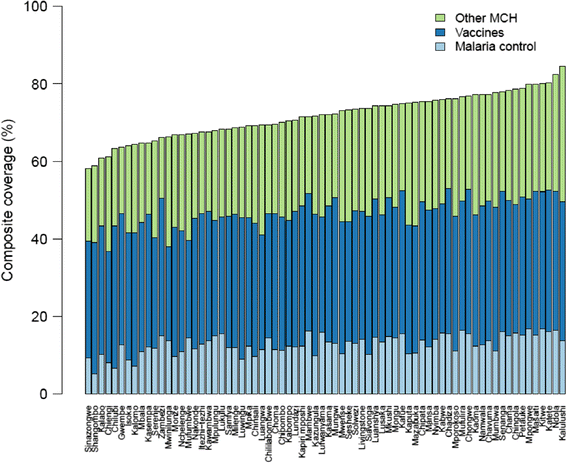Benchmarking health system performance across districts in Zambia: a systematic analysis of levels and trends in key maternal and child health interventions from 1990 to 2010
- PMID: 25889124
- PMCID: PMC4382853
- DOI: 10.1186/s12916-015-0308-5
Benchmarking health system performance across districts in Zambia: a systematic analysis of levels and trends in key maternal and child health interventions from 1990 to 2010
Abstract
Background: Achieving universal health coverage and reducing health inequalities are primary goals for an increasing number of health systems worldwide. Timely and accurate measurements of levels and trends in key health indicators at local levels are crucial to assess progress and identify drivers of success and areas that may be lagging behind.
Methods: We generated estimates of 17 key maternal and child health indicators for Zambia's 72 districts from 1990 to 2010 using surveys, censuses, and administrative data. We used a three-step statistical model involving spatial-temporal smoothing and Gaussian process regression. We generated estimates at the national level for each indicator by calculating the population-weighted mean of the district values and calculated composite coverage as the average of 10 priority interventions.
Results: National estimates masked substantial variation across districts in the levels and trends of all indicators. Overall, composite coverage increased from 46% in 1990 to 73% in 2010, and most of this gain was attributable to the scale-up of malaria control interventions, pentavalent immunization, and exclusive breastfeeding. The scale-up of these interventions was relatively equitable across districts. In contrast, progress in routine services, including polio immunization, antenatal care, and skilled birth attendance, stagnated or declined and exhibited large disparities across districts. The absolute difference in composite coverage between the highest-performing and lowest-performing districts declined from 37 to 26 percentage points between 1990 and 2010, although considerable variation in composite coverage across districts persisted.
Conclusions: Zambia has made marked progress in delivering maternal and child health interventions between 1990 and 2010; nevertheless, substantial variations across districts and interventions remained. Subnational benchmarking is important to identify these disparities, allowing policymakers to prioritize areas of greatest need. Analyses such as this one should be conducted regularly and feed directly into policy decisions in order to increase accountability at the local, regional, and national levels.
Figures





Similar articles
-
Benchmarking health system performance across regions in Uganda: a systematic analysis of levels and trends in key maternal and child health interventions, 1990-2011.BMC Med. 2015 Dec 3;13:285. doi: 10.1186/s12916-015-0518-x. BMC Med. 2015. PMID: 26631048 Free PMC article.
-
Benchmarking health system performance across states in Nigeria: a systematic analysis of levels and trends in key maternal and child health interventions and outcomes, 2000-2013.BMC Med. 2015 Sep 2;13:208. doi: 10.1186/s12916-015-0438-9. BMC Med. 2015. PMID: 26329607 Free PMC article.
-
Investment case for improving maternal and child health: results from four countries.BMC Public Health. 2013 Jun 21;13:601. doi: 10.1186/1471-2458-13-601. BMC Public Health. 2013. PMID: 23800035 Free PMC article.
-
Benchmarking of performance of Mexican states with effective coverage.Lancet. 2006 Nov 11;368(9548):1729-41. doi: 10.1016/S0140-6736(06)69566-4. Lancet. 2006. PMID: 17098091 Review.
-
Maternal, neonatal and child health in Pakistan: towards the MDGs by moving from desire to reality.East Mediterr Health J. 2010;16 Suppl:S39-46. East Mediterr Health J. 2010. PMID: 21495587 Review.
Cited by
-
Health system lessons from the global fund-supported procurement and supply chain investments in Zimbabwe: a mixed methods study.BMC Health Serv Res. 2024 May 1;24(1):557. doi: 10.1186/s12913-024-11028-6. BMC Health Serv Res. 2024. PMID: 38693548 Free PMC article.
-
Assessing the Contribution of Malaria Vector Control and Other Maternal and Child Health Interventions in Reducing All-Cause Under-Five Mortality in Zambia, 1990-2010.Am J Trop Med Hyg. 2017 Sep;97(3_Suppl):58-64. doi: 10.4269/ajtmh.15-0315. Am J Trop Med Hyg. 2017. PMID: 26880778 Free PMC article.
-
Mapping exclusive breastfeeding in Africa between 2000 and 2017.Nat Med. 2019 Aug;25(8):1205-1212. doi: 10.1038/s41591-019-0525-0. Epub 2019 Jul 22. Nat Med. 2019. PMID: 31332393 Free PMC article.
-
Small area estimation of under-5 mortality in Bangladesh, Cameroon, Chad, Mozambique, Uganda, and Zambia using spatially misaligned data.Popul Health Metr. 2018 Aug 13;16(1):13. doi: 10.1186/s12963-018-0171-7. Popul Health Metr. 2018. PMID: 30103791 Free PMC article.
-
Subnational benchmarking of health systems performance in Africa using health outcome and coverage indicators.BMC Med. 2015 Dec 14;13:299. doi: 10.1186/s12916-015-0541-y. BMC Med. 2015. PMID: 26654445 Free PMC article.
References
-
- Sustainable Development Knowledge Platform. Open working group proposal for sustainable development goals. https://sustainabledevelopment.un.org/sdgsproposal.
-
- Braveman P, Tarimo E. Social inequalities in health within countries: not only an issue for affluent nations. Soc Sci Med 1982. 2002;54:1621–35. - PubMed
Publication types
MeSH terms
LinkOut - more resources
Full Text Sources
Other Literature Sources
Medical

